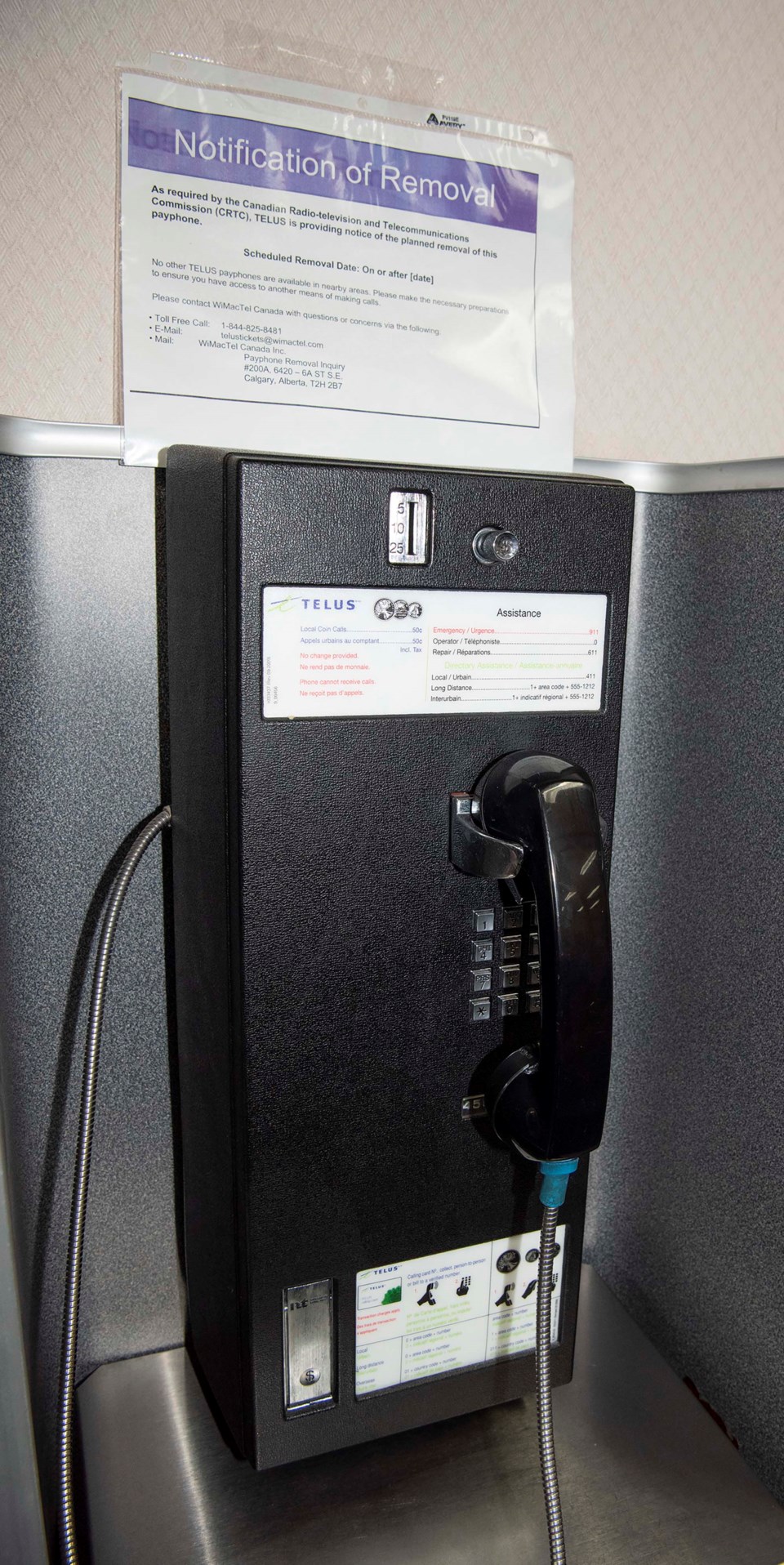St. Albert’s last payphone will be hanging up for good in two months' time.
Mayor Cathy Heron posted a notice on Facebook Jan. 17 that she had received a note on how the city’s last payphone would be removed on or after March 25, due to a decline in use. A similar notice was posted above the payphone in question in the Grandin Medical Clinic.
In an email, Telus spokesperson Chelsey Rajzer said payphone use has steadily declined over the last 20 years due to the popularity and availability of cellphones in Canada. Telus started removing payphones about six years ago as a result.
Rajzer said Telus is confident that removing the Grandin Clinic phone will not affect the community — it was hardly ever used, generating less than $5 in calls (at $0.50 a call) in 2020 and 2021, and there are other phones at the clinic available for use in emergencies.
The first payphone
The telephone has a storied place in St. Albert’s history, as this community was host to one of the first two phones in Alberta. Installed in the store of Henry McKenney (St. Albert’s first MLA and the namesake of McKenney Avenue) in 1885, the phone was originally built in London, England, and connected to a similar device in Edmonton, reports historian Tony Cashman. As you had to pay 15 cents to use the device, it was arguably St. Albert’s first payphone.
The first call on the phone was from Edmonton operator Alex Taylor to one Narcisse St. Jean at 4 p.m. on Jan. 3, 1885, Cashman writes.
“We wish you a Happy New Year,” Taylor said.
“The people of St. Albert congratulate the people of Edmonton on telephone communications being established between these two places and wish the clergy and people a happy New Year,” St. Jean replied.
St. Albert’s paid phone didn’t last long, Cashman writes. On May 11, 1885, during the height of the North-West Resistance, a call came in on the phone from St. Albert that 1,500 Indigenous people had killed everyone in Fort Saskatchewan and burned it to the ground. Area residents fled for their lives to Fort Edmonton all weekend until a very-much-alive man from the very-not-burned Fort Saskatchewan showed up to ask what all the fuss was about, exposing the phone report as false.
It’s unclear if this incident convinced McKenney to ditch his phone, but he did so all the same a week later, Cashman writes. The phone returned later that year to the home of Father Lestanc.
Cashman does not specify when the first coin-operated payphone arrived in St. Albert. The first one in the Edmonton region was installed in March 1899 at K.W. McKenzie’s bookstore on Jasper Avenue. To use it, callers had to deposit a silver five-cent piece into a metal box with a slot on it atop the phone. As the phone did not have an automatic coin-detector, the operator had to listen for the ping of the coin drop to confirm payment.
“In case of doubt, the customer was always right,” Cashman writes.
Dr. Ken Chow said the Grandin Clinic payphone was installed soon after he joined the organization in 1975. Staff brought it in so patients wouldn’t have to borrow the clinic’s regular phones to make a call and potentially hear confidential medical information in the process.
Hanging up for good
Payphones were once ubiquitous in St. Albert, found at convenience stores, shopping malls and street corners. Rajzer said there are maybe 700 active Telus payphones in Alberta today.
St. Albert residents reacted with a mix of sarcasm and nostalgia to news of the phone’s removal on Facebook. Some were concerned about how the removal would affect seniors or those who live in poverty, while others suggested the phone go into a museum.
In an email, Coun. Natalie Joly said she was part of the last generation to grow up without cellphones and as a youth had carried a quarter in case she needed to use a payphone to call home.
“My kids can’t fathom using a payphone. The last decades have seen an incredible shift in how we communicate.”
St. Albert Food Bank executive director Suzan Krecsy said in an email that she had not heard of any of her clients using a payphone, and that most had cellphones instead. The food bank has partnered with Bell/United Way to give clients replacement cellphones as well.
Musée Héritage Museum curator Joanne White said the museum is not interested in adding the Grandin Clinic phone to its collection as it already has a similar model in storage.
“In some ways, it’s too bad,” she said of the planned removal.
“If your cellphone doesn’t work, having options is nice.”
Questions on the Grandin Clinic payphone removal should go to WiMacTel Canada at 1-844-825-8481.



